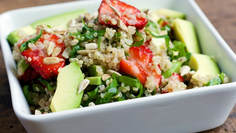
You probably already know that it’s a seed not a grain, but because of its nutritional content and general go-with-anythingness we can use it like a grain. It’s one of several foods known as pseudograins, which are the seeds of broadleaf plants (non-grasses). Being in the goosefoot family means it’s more closely related to beetroot, chard and spinach than to cereals.
If these ‘anti-nutrients’ are not rinsed off, they cause little holes in the lining of your intestine However, turns out, despite all the above, quinoa could be damaging your gut and doing more harm than good. Digestion of quinoa isn’t quite so easy for our bodies. Why? Because of some rather bothersome molecules in the seeds’ protective coating, called saponins.
The problem with saponins and your intestines
The seed of a plant contains the embryo, and a plant’s mission is to pass on its genes, so the seed has this outer coating to protect the plant from microbes, insects and predators. It also helps the seed to withstand its passage through the digestive tracts of the animals upon which it relies for propagation, so that it can be safely pooped out and planted in new soil. But if these saponins (known as ‘anti-nutrients’) are not rinsed off before cooking, they cause little holes in the lining of our intestine, increasing its permeability and causing the gut’s contents to leak into the body. A condition called, neatly, leaky gut.
The cells that line the gut (imagine them like tiles on a wall) are naturally permeable, so that very small molecules can pass through. It’s how vital nutrients from our food get absorbed into the body. But when saponins punch holes in the membranes of the microvilli (cells) in the small intestine, the ‘tight junctions’ between these cells (imagine these like the spaces between the tiles) start to break apart. This is leaky gut.
Once this happens, toxins, microbes and undigested food particles pass through the gut wall into the bloodstream, which they are not meant to do. They have no business at all being there, and have a high old time galivanting around the body causing problems.
Gut attack! The start of systemic inflammationThis makes your immune system spring into action. It marks these ‘foreign invaders’ as pathogens and attacks them, causing systemic inflammation. This could be the reason behind minor or more serious problems you might be experiencing, including digestion, skin, achy joints, tummy pain, weight gain and fatigue. Leaky gut can be the root of:
- Digestive issues such as gas, bloating, diarrhoea, IBS or candida.
- Food allergies or food intolerances.
- Seasonal allergies or asthma.
- Skin issues e.g. acne, rosacea or eczema.
- Mood and mind issues such as depression, anxiety, ADD or ADHD.
- Hormone imbalances e.g. PMS or PCOS.
What to do to make quinoa safe
However, all you need to do is rinse your quinoa before you cook it. Put it in a fine sieve, rinse it under warm water (not cold) until the water runs clear (important, that) then cook as usual. Some organic brands are pre-washed and may say so on the packet, but I’ve not yet found one that does. So wash the brand you have and if the water’s not at all ‘soapy’, you’re probably OK.
Personally, even if the water runs pretty clear, the vision of small leaky holes in my intestinal wall is enough to make me rinse it every time. And two more FYIs on quinoa: if you’ve ever thought it tastes soapy, it is: in South America the saponin residue is used as detergent. And the increased world demand for quinoa has pushed the price so high that workers in Peru and Bolivia who grow it, for whom it was once their staple food, can no longer afford to eat it. Just a little ethical issue for you to digest.
Jacqui Gibbons is the editor of High50’s health channel, edits beauty and lifestyle features, and writes about health trends. Twitter @jacqui_journo
http://www.high50.com/health/quinoa-saponins-and-leaky-gut
 RSS Feed
RSS Feed